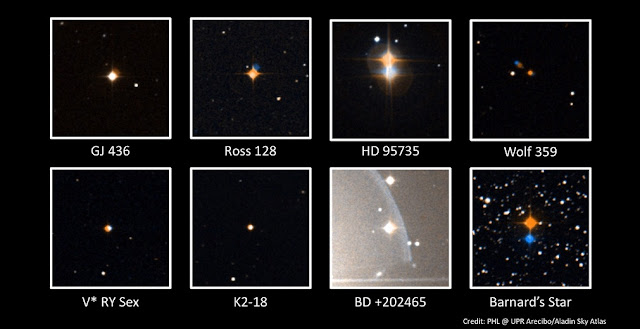The National Science Foundation’s Arecibo Observatory and the Planetary Habitability Laboratory of the University of Puerto Rico at Arecibo joined the Red Dots project using the ESO’s exoplanet-hunter in the search for new planets around our nearest stars. This new collaboration will simultaneously observe in both the optical and radio spectrum Barnard’s Star, a popular star in the science fiction literature.
Barnard's star is a low-mass red dwarf almost six light-years away and the second-closest stellar system to our Sun after the Alpha Centauri triple-star system. There are hints of a possible super-Earth mass planet in a cold orbit around this star.
The Arecibo Observatory has a new campaign to observe nearby red dwarf stars with planets. The purpose of this campaign is to detect radio emissions from these stars, such as from flares, to help characterize their radiation and magnetic environment and any potential perturbations due to other bodies. These perturbations might reveal the presence of new sub-stellar objects including planets.
Barnard’s Star will be the eighth red dwarf star to be recently observed by the Arecibo Observatory. Results from Gliese 436, Ross 128, Wolf 359, HD 95735, BD +202465, V* RY Sex, and K2-18 are currently being analyzed. These observations are led by Prof. Abel Méndez, Director of the Planetary Habitability Laboratory of the University of Puerto Rico at Arecibo in collaboration with Dr. Jorge Zuluaga from the Universidad de Antioquia in Colombia.
The Red Dots team will be joining the observations with the Arecibo Observatory of Barnard’s Star in coordination with other observatories. They are planning simultaneous photometric and spectral observations from SNO, LCO, TJO, and CARMENES from Spain, and earlier with ASH2 from Chile. All these observations will be used to understand the star but more observations using the ESO’s exoplanet-hunter by the Red Dots team will be necessary for the detection and confirmation of any new planet.
The first extrasolar planets were discovered from the Arecibo Observatory in 1992. They were three small planets named Draugr, Poltergeist, and Phobetor around the Lich Pulsar, a fast rotating neutron star that emits a beam of electromagnetic radiation. The first planet around a sun-like star was later discovered in 1995 and today we know of more than 3,500 of them. Recent observations by the Arecibo Observatory have been able to detect brown dwarfs, but no new planet yet.
The first and only time that Barnard’s Star was observed from the Arecibo Observatory was during the SETI Institute’s Phoenix Project (1998-2004). The new observations are in a different frequency (4 to 5 GHz) where radio emission from stellar flares have been observed in other similar or cooler objects. This is the first time Barnard’s Star is seen with such frequencies and sensitivity.
The observations of Barnard’s Star will take place on Sunday, July 16. Another star, Ross 128, will be observed again later that day because it showed potential radio emissions that require follow-up. Results from these observations will be available later that week. The Red Dots team keeps an open journal of their observational campaign.
Credit: phl.upr.edu

No comments:
Post a Comment